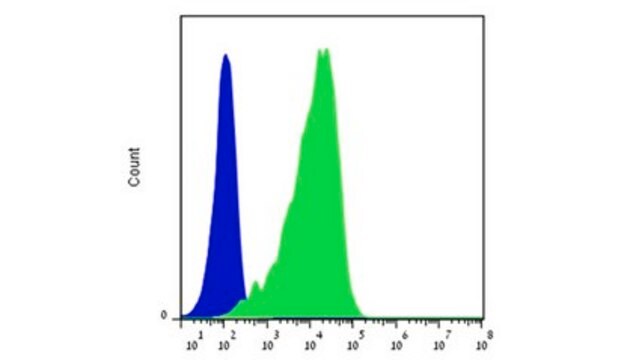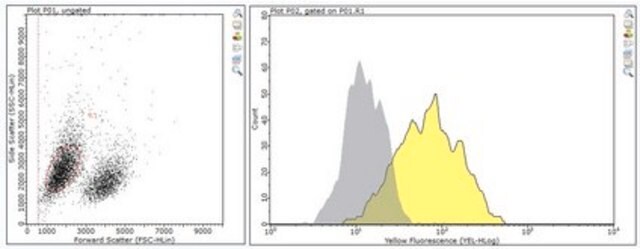MABF1970M
Anti-NKp46 (CD335) Antibody, clone WEN23
clone WEN23, from mouse, purified by affinity chromatography
Sinónimos:
Natural cytotoxicity triggering receptor 1, Activating receptor 1, rAR-1, Lymphocyte antigen 94 homolog, NK receptor KILR-1, NKACTR, Natural killer cell p46-related protein, NK-p46, NKp46, CD335
About This Item
Productos recomendados
origen biológico
mouse
Nivel de calidad
forma del anticuerpo
purified antibody
tipo de anticuerpo
primary antibodies
clon
WEN23, monoclonal
purificado por
affinity chromatography
reactividad de especies
rat
envase
antibody small pack of 25 μL
técnicas
flow cytometry: suitable
immunohistochemistry: suitable
immunoprecipitation (IP): suitable
western blot: suitable
isotipo
IgG1κ
Nº de acceso NCBI
Nº de acceso UniProt
modificación del objetivo postraduccional
unmodified
Información sobre el gen
rat ... Ncr1(117547)
Descripción general
Especificidad
Inmunógeno
Aplicación
Inflammation & Immunology
Affects Function Analysis: A representative lot of anti-NKp46 (CD335) affected funtion of NKp46 (CD335). (Westgaard, I.H., et. al. (2004). J Leukoc Biol. 76(6):1200-6).
Immunoprecipitation Analysis: A representative lot detected NKp46 (CD335) in Immunoprecipitation applications (Westgaard, I.H., et. al. (2004). J Leukoc Biol. 76(6):1200-6).
Flow Cytometry Analysis: A representative lot detected NKp46 (CD335) in Flow Cytometry applications (Westgaard, I.H., et. al. (2004). J Leukoc Biol. 76(6):1200-6).
Immunohistochemistry Analysis: A representative lot detected NKp46 (CD335) in Immunohistochemistry applications (Smelt, M.J., et. al. (2014). Cell Transplant. 23(11):1381-94).
Calidad
Flow Cytometry Analysis: 1 µg of this antibody detected NKp46 (CD335) in HEK293 cells transfected with rat NKp46.
Descripción de destino
Forma física
Almacenamiento y estabilidad
Otras notas
Cláusula de descargo de responsabilidad
¿No encuentra el producto adecuado?
Pruebe nuestro Herramienta de selección de productos.
Código de clase de almacenamiento
12 - Non Combustible Liquids
Clase de riesgo para el agua (WGK)
WGK 2
Punto de inflamabilidad (°F)
Not applicable
Punto de inflamabilidad (°C)
Not applicable
Certificados de análisis (COA)
Busque Certificados de análisis (COA) introduciendo el número de lote del producto. Los números de lote se encuentran en la etiqueta del producto después de las palabras «Lot» o «Batch»
¿Ya tiene este producto?
Encuentre la documentación para los productos que ha comprado recientemente en la Biblioteca de documentos.
Nuestro equipo de científicos tiene experiencia en todas las áreas de investigación: Ciencias de la vida, Ciencia de los materiales, Síntesis química, Cromatografía, Analítica y muchas otras.
Póngase en contacto con el Servicio técnico








